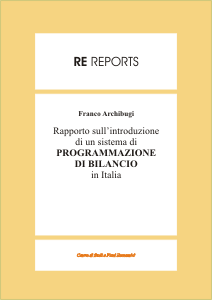CONTENTS
First Part
Ideas concerning the introduction of a system of programme budgeting in Italy and a proposal of two researches
1. The ‘Progetto 80’ and the formulation of programmes of public expenditure
2. The programme harmonisation with the preparation of the balances
3. A first research: the construction of a “programme structure” based on the objectives of the National Programme and the Progetto 80
4. Characterisation of indicators of the degree to which programming objectives have been achieved
5. A second research: a procedure of introducing a system of Programme Budgeting, embedded in the context of a current procedure of the formulation and the approval of budgeting in Italy
6. Quick recall to the PPBS procedure, with reference to the proposed research goal
7. The analytical follow-up to the proposed researches
Second Part
Methodological and procedural aspects of Programme Budgeting (7 appendices)
Appendix 1
General considerations on the programme analyses and on the preparation of a “programme structure”
1. A programme analysis - what it is and what it should serve for, in general
2. The “structure” of the activities used within the aims of the planning of expenditures can either be the same as that used within the aims of the formal control of itself, or not
3. The classification of the different activities has to happen according to their final results and not according to the existent administrative structures
4. Flexibility but conformity of programme structures at different levels
5. Principal tasks in the preparation of a programme structure
6. Identification of the fundamental objectives of the government
7. Development of the specific programme categories
8. Necessity of aclassification principle or key for the highest levels
9. The categories of the lowest levels: those ‘isolated’ from the programme
10. Bases of classification
11. Programmes with multiple objectives
12. Activity of assistance to multiple applications
13. How many levels have to be planned for?
14. Measures adapted to future changes
15. The need for special groupings
16. Formulation of the descriptive relations
Appendix 2
Description of a programme-type structure at the level of the whole governmental unity
1. Personal security
2. Health (physical and mental well being)
3. Intellectual development and personal enrichment
4. Satisfying housing and community surroundings
5. Economic satisfaction and satisfying work opportunities for every individual
6. Satisfying opportunities for the free time
7. General administration and services
Appendix 3
The programme structure of an individual administration: the example of the American Department for Housing and Urban Development
1. Assure decent housing for all citizens
2. Assure local public and private services and facilities, adequate and efficient
3. Provide for the amelioration of the physical environment of the urban community
4. Provide for the amelioration of the social environment of the urban community
5. Provide for the amelioration of the administration of activities to develop the urban community
6. Provide for the amelioration of the administration of resources and ministerial programmes
Appendix 4
Criteria or measurement of potency and the indicators of goals achievement
1. Principle examples for ‘criteria’
a. Personal security
b. Health
c. Intellectual development
d. Satisfying housing and community surroundings
e. Economic satisfaction and satisfying work opportunities for everyone
f. Opportunity for a satisfying free-time
g. Good access to goods and services: Transport, communication, localisation
2. Some problems connected to the definition of the criteria
a. Why is there a need for cost analyses?
b. Where are cost analyses being used?
c. What would have to encompass the costs?
d. Administrative and organisational aspects of the cost analyses
Appendix 5
Procedure of a programme budgeting according to the scheme adopted at a federal level in the US
1. General scope and nature of the Programme Budgeting (PB)
2. The structure of the documents to be prepared in the frame of a Programme Budgeting (the federal American experience)
3. The “Principal Programme Projects” (PPP)
4. The “Programme Structure” (PS)
5. How to treat the supportive and indirect activities in the PS
6. The adaptation of the PS to the demands of the decisional process
7. Relation with other classifications
8. The “Programme Memorandum” (PM)
9. Contents of the PM
10. Procedural prerequisites of transmission of the PM
11. The “Special Analytical Studies” (SAS)
12. The “Operative and Financial Plans” (OFP)
13. Horizon and content of the OFP
14. Procedural prerequisites of transmission of the OFP
15. Relation of the OFP with the PM and the SAS
16. Timing and transmission of the documents concerning the PB
17. Responsibility, functioning and practice requested by the system of the PB
18. American administrations to which the described procedures have been extended
Appendix 7
A guide to the formulation of the multi-year “Operative Financial Plans” (OFP) from the side of the individual State administrations or agencies
1. Production concept
2. Concept of costs. The programme level
3. The concept of controllability. The “classification of the commitment ”
4. Guidelines for the projection
